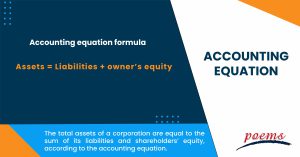Accounting Equation
Table of Contents
Accounting equation
A fundamental accounting equation formula was created in 1494 by the Italian mathematician Luca Pacioli in his book “A Treatise on Accounts and Records.” The accounting equation demonstrates how a change in one of a company’s assets, liabilities, or equity often causes a change in the other two. This formula is based on the double-entry method of accounting, in which every asset, liability, or equity account experiences a positive or negative change due to at least two transactions.
What is the accounting equation?
The total assets of a corporation are equal to the sum of its liabilities and shareholders’ equity, according to the accounting equation.
The relationship between assets, liabilities, and equity is a basic premise of the double-entry accounting system. The accounting equation guarantees the balance of the balance sheet. To put it another way, every debit item has a corresponding credit entry on the opposing side of the ledger (or coverage). The balance sheet or basic accounting equation are other names for the accounting equation.
Understanding the accounting equation
By applying an accounting calculation, you may determine whether a company’s total assets match its total liabilities and shareholders’ total equity. It upholds a connection between a corporation’s assets, liabilities, cash flow, and total equity.
The balance sheet is kept up to date using the accounting equation. However, it’s crucial to make sure that there is a credit entry for every debit entry. The accounting equation balances debits and credits.
Accounting equation formula and calculation

The formula for the accounting equation is the following:
Assets = Liabilities + owner’s equity
Each transaction must have an equal net effect on both sides. For example, Business ABC wants to spend all its cash on a US$500 machine. Cash would experience a credit (a drop in an asset), and Equipment would experience a debit (a rise in an asset) due to this transaction. The following is how it impacts the accounting equation:
Assets = liabilities + owner’s equity = US$500 US$ – US$500
There is no comparable impact on the shareholder’s equity or liabilities on the right side of the equation because this transaction only affects the assets.
Limits of the accounting equation
The accounting equation has limits, despite how useful it is for accounting in your organisation. To begin with, it doesn’t offer a review of the business’s performance to investors or other relevant third parties.
Also, it doesn’t entirely guard against accounting mistakes. Even when the balance sheet balances itself, there is a potential for inaccuracy that does not involve the accounting equation. The absence of a monetary value in an event or condition prevents the accounting equation from measuring them.
Any event that does not have a monetary value, such as management, reputation, or loyalty, has no place in the accounting equation. The accounting equation employs predetermined costs to assess values and ignore variables like inflation, price fluctuation, etc., losing the relevance of accounting information in the process. Since humans are a part of the accounting equation, there will always be room for error and harder-to-identify fraud.
Accounting equation importance
The accounting equation aims to guarantee the accuracy of a company’s financial reporting. Assets, liabilities, and equity, the three components of the accounting equation, give a quick overview of a company’s financial situation.
Accountants may ensure the financial accounts are accurate by checking that these three components balance. There are at least two accounts involved in every financial transaction. It shows what a company received and what it gave back.
For instance, it might pay cash for goods (decreasing assets) or get a bank loan (rising assets and liabilities), which together form the foundation of all finances. This straightforward calculation can generate the cash flow statement, balance sheet, and income statement. The accounting equation also contributes to a company’s financial reporting accuracy.
Frequently Asked Questions
The accounting equation is a fundamental concept in accounting that states that all assets of a business are equal to the sum of its liabilities and equity. The equation is represented as follows:
Assets = Liabilities + Equity
The left side of the equation represents the company’s resources used to finance its activities. The right side of the equation represents the company’s financing sources, including loans, investments by shareholders, and other forms of financing.
The accounting equation is important because it ensures that a company’s assets always equal its liabilities and equity. This is important because it means a company’s financial statements are always balanced.
In accounting, an asset can be used to generate economic value. This includes items like cash, investments, inventory, and property. The accounting equation is a way of representing the relationship between assets and liabilities.
On one side of the equation are the company’s assets, while on the other are the company’s liabilities. The equation must always balance, meaning that the total value of assets must always equal the total value of liabilities.
A liability is a financial obligation of a company, typically recorded on the balance sheet. Liabilities include debts owed to vendors and suppliers, loans from financial institutions, and lease obligations. The accounting equation represents liabilities as a company’s total debts and obligations minus its total assets.
The accounting equation is used by businesses to track and report their financial activity. Accountants use this equation to prepare financial statements, and managers decide where to allocate resources. Investors and creditors also use the equation to assess a company’s financial health.
The balance sheet demonstrates that total assets equal total liabilities and owner’s equity, just like the accounting equation. One of the final processes in the accounting cycle is creating the balance sheet statement, which comes after double-entry bookkeeping.
Related Terms
- Trailing Stops
- Exchange Control
- Relevant Cost
- Dow Theory
- Hyperdeflation
- Hope Credit
- Futures contracts
- Human capital
- Subrogation
- Qualifying Annuity
- Strategic Alliance
- Probate Court
- Procurement
- Holding company
- Harmonic mean
- Trailing Stops
- Exchange Control
- Relevant Cost
- Dow Theory
- Hyperdeflation
- Hope Credit
- Futures contracts
- Human capital
- Subrogation
- Qualifying Annuity
- Strategic Alliance
- Probate Court
- Procurement
- Holding company
- Harmonic mean
- Income protection insurance
- Recession
- Savings Ratios
- Pump and dump
- Total Debt Servicing Ratio
- Debt to Asset Ratio
- Liquid Assets to Net Worth Ratio
- Liquidity Ratio
- Personal financial ratios
- T-bills
- Payroll deduction plan
- Operating expenses
- Demand elasticity
- Deferred compensation
- Conflict theory
- Acid-test ratio
- Withholding Tax
- Benchmark index
- Double Taxation Relief
- Debtor Risk
- Securitization
- Yield on Distribution
- Currency Swap
- Overcollateralization
- Efficient Frontier
- Listing Rules
- Green Shoe Options
- Accrued Interest
- Market Order
- Accrued Expenses
- Target Leverage Ratio
- Acceptance Credit
- Balloon Interest
- Abridged Prospectus
- Data Tagging
- Perpetuity
- Hybrid annuity
- Investor fallout
- Intermediated market
- Information-less trades
- Back Months
- Adjusted Futures Price
- Expected maturity date
- Excess spread
- Quantitative tightening
- Accreted Value
- Equity Clawback
- Soft Dollar Broker
- Stagnation
- Replenishment
- Decoupling
- Holding period
- Regression analysis
- Wealth manager
- Financial plan
- Adequacy of coverage
- Actual market
- Credit risk
- Insurance
- Financial independence
- Annual report
- Financial management
- Ageing schedule
- Global indices
- Folio number
- Accrual basis
- Liquidity risk
- Quick Ratio
- Unearned Income
- Sustainability
- Value at Risk
- Vertical Financial Analysis
- Residual maturity
- Operating Margin
- Trust deed
- Leverage
- Profit and Loss Statement
- Junior Market
- Affinity fraud
- Base currency
- Working capital
- Individual Savings Account
- Redemption yield
- Net profit margin
- Fringe benefits
- Fiscal policy
- Escrow
- Externality
- Multi-level marketing
- Joint tenancy
- Liquidity coverage ratio
- Hurdle rate
- Kiddie tax
- Giffen Goods
- Keynesian economics
- EBITA
- Risk Tolerance
- Disbursement
- Bayes’ Theorem
- Amalgamation
- Adverse selection
- Contribution Margin
- Value chain
- Gross Income
- Net present value
- Liability
- Leverage ratio
- Inventory turnover
- Gross margin
- Collateral
- Being Bearish
- Being Bullish
- Commodity
- Exchange rate
- Basis point
- Inception date
- Riskometer
- Trigger Option
- Zeta model
- Racketeering
- Market Indexes
- Short Selling
- Quartile rank
- Defeasance
- Cut-off-time
- Business-to-Consumer
- Bankruptcy
- Acquisition
- Turnover Ratio
- Indexation
- Fiduciary responsibility
- Benchmark
- Pegging
- Illiquidity
- Backwardation
- Backup Withholding
- Buyout
- Beneficial owner
- Contingent deferred sales charge
- Exchange privilege
- Asset allocation
- Maturity distribution
- Letter of Intent
- Emerging Markets
- Consensus Estimate
- Cash Settlement
- Cash Flow
- Capital Lease Obligations
- Book-to-Bill-Ratio
- Capital Gains or Losses
- Balance Sheet
- Capital Lease
Most Popular Terms
Other Terms
- Physical ETF
- Initial Public Offering
- Buyback
- Secondary Sharing
- Bookrunner
- Notional amount
- Negative convexity
- Jumbo pools
- Inverse floater
- Forward Swap
- Underwriting risk
- Reinvestment risk
- Final Maturity Date
- Payment Date
- Secondary Market
- Margin Requirement
- Mark-to-market
- Pledged Asset
- Yield Pickup
- Subordinated Debt
- Treasury Stock Method
- Stochastic Oscillator
- Bullet Bonds
- Basket Trade
- Contrarian Strategy
- Notional Value
- Speculation
- Stub
- Trading Volume
- Going Long
- Pink sheet stocks
- Rand cost averaging
- Sustainable investment
- Stop-limit sell order
- Economic Bubble
- Ask Price
- Constant prepayment rate
- Covenants
- Stock symbol
- Companion tranche
- Synthetic replication
- Bourse
- Beneficiary
- Witching Hour
- Widow and Orphan stock
- Public Float
- Closing Price
- Reverse stock splits
- Quiet period
- Prepayment risk
Know More about
Tools/Educational Resources
Markets Offered by POEMS
Read the Latest Market Journal

Back in Business: The Return of IPOs & Top Traded Counters in March 2024
Start trading on POEMS! Open a free account here! At a glance: Major indices continue...

Weekly Updates 15/4/24 – 19/4/24
This weekly update is designed to help you stay informed and relate economic and company...

From $50 to $100: Unveiling the Impact of Inflation
In recent years, inflation has become a hot topic, evoking strong emotions as the cost...

Japan’s Economic Resurgence: Unveiling the Tailwinds Behind Nikkei 225’s Record Leap
Source: eSignal, Intercontinental Exchange, Inc. In the heart of Japan’s economic landscape, the Nikkei 225...

Weekly Updates 8/4/24 – 12/4/24
This weekly update is designed to help you stay informed and relate economic and...

What Makes Forex Trading Attractive?
In a world where the click of a button can send goods across oceans and...

Weekly Updates 1/4/24 – 5/4/24
This weekly update is designed to help you stay informed and relate economic and company...

How to soar higher with Positive Carry!
As US Fed interest rates are predicted to rise 6 times this year, it’s best...












